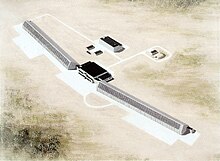Dnepr radar

A US military artist's concept of a Dnestr-M/Dnepr.
|
|
| Country of origin | Soviet Union, Russia |
|---|---|
| Introduced | 1963 (Dnestr-M) |
| No. built | 15 |
| Type |
space surveillance (Dnestr) Early warning radar (Dnestr-M, Dnepr, Dnepr-M) |
| Frequency | 154–162 MHz (VHF) |
| Beamwidth | 0.5°(N-S), 10°(E-W) |
| Pulsewidth | 0.8 ms long |
| Range | 3,000 kilometres (1,864 mi) 1,900 kilometres (1,181 mi) for targets with an area of 1 m2 |
| Diameter | Each array is 244 metres (801 ft) long, 20 metres (66 ft) high and 12 metres (39 ft) wide |
| Azimuth | 30°, 30 per transmitter giving 120 in total |
| Elevation | 5° to 35° |
| Precision | ± 1 km range, 10 min azimuth, 50 min elevation, 5 m/s range rate |
| Power | peak power of 1.25 MW per transmitter Radiating power 200 kW Consumed power 2100 kW |
| Other Names |
NATO: Hen House GRAU: 5N15 (Dnestr), 5N15M (Dnestr-M), 5N86 (Dnepr) |
Dnestr radar (Russian: Днестр) and Dnepr radar (Russian: Днепр), both known by the NATO reporting name Hen House are the first generation of Soviet space surveillance and early warning radars. Six radars of this type were built around the periphery of the Soviet Union starting in the 1960s to provide ballistic missile warnings for attacks from different directions. They were the primary Soviet early warning radars for much of the later Cold War. In common with other Soviet and Russian early warning radars they are named after rivers, the Dnestr and the Dnepr.
The Dnestr/Dnepr radars were intended to be replaced by the newer Daryal radars starting in the 1990s. Only two of the planned Daryal radars became operational, due to issues such as the dissolution of the Soviet Union. As of 2012, the Russian early warning network still consists of some radars of this vintage. It is likely that all the existing radars will be replaced by the third generation Voronezh radars by 2020.
The Dnestr radar came from work on ballistic missile defence undertaken in the late 1950s and early 1960s. System A, the prototype for the A-35 anti-ballistic missile system, was set up in the Sary Shagan testing grounds, in the Kazakh SSR. Work on the system was led by design bureau KB-1 which proposed using VHF radar RTN (Russian: РТН) and the Dunay-2 UHF radar. Other alternatives were sought from Soviet industry and RTI proposed using VHF radar TsSO-P (Russian: ЦСО-П) and UHF radar TsSS-30 (Russian: ЦСС-30).
...
Wikipedia
